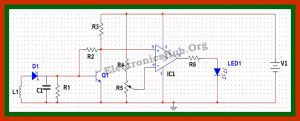The most common electronic equipment used is cell phones. With advancement in communication technology, the requirement of cell phones has increased manifold. A cell phone typically transmits and receives signals in the frequency range of 0.9 to 3GHz. This article provides a simple circuit to detect the presence of an activated cell phone by detecting these signals.
Basic Principle of Mobile Phone Detector Circuit:
The basic principle behind this circuit is the idea of using a Schottky diode to detect the cell phone signal. Mobile phone signal is in the frequency range of 0.9 to 3GHZ. Schottky diodes have a unique property of being able to rectify low frequency signals, with low noise rate. When an inductor is placed near the RF signal source, it receives the signal through mutual induction. This signal is rectified by the Schottky diode. This low power signal can be amplified and used to power any indicator like an LED in this case.
Circuit Diagram of Cell Phone Detector:
Circuit Components:
- V1 = 12V
- L1 = 10uH
- R1 = 100Ohms
- C1 = 100nF
- R2 = 100K
- R3 = 3K
- Q1 = BC547
- R4 = 200 Ohms
- R5 = 100 Ohms
- IC1= LM339
- R6 = 10 Ohms
- LED = Blue LED
Cell Phone Detector Circuit Design:
Detector Circuit Design:
The detector circuit consists of an inductor, diode, a capacitor and a resistor. Here an inductor value of 10uH is chosen. A Schottky diode BAT54 is chosen as the detector diode, which can rectify low frequency AC signal. The filter capacitor chosen in a 100nF ceramic capacitor, used to filter out AC ripples. A load resistor of 100 Ohms is used.
Amplifier Circuit Design:
Here a simple BJT BC547 is used in common emitter mode. Since the output signal is of low value, the emitter resistor is not required in this case. The collector resistor value is determined by the value of battery voltage, collector emitter voltage and collector current. Now the battery voltage is chosen to be 12 V (since maximum open source collector emitter voltage for BC 547 is 45V), operating point collector emitter voltage is 5 V and collector current is 2 mA. This gives a collector resistor of approx 3 K. Thus a 3 K resistor is used as Rc. The input resistor is used to provide bias to the transistor and should be of larger value, so as to prevent the flow of maximum current. Here we chose a resistor value of 100 K.
Comparator circuit Design:
Here LM339 is used as comparator. The reference voltage is set at the inverting terminal using a potential divider arrangement. Since output voltage from the amplifier is quite low, the reference voltage is set low of the order of 4V. This is achieved by selecting a resistor of 200 Ohms and a potentiometer of 330 Ohms. An output resistor of value 10 Ohms is used as a current limiting resistor.
Mobile Phone Tracking Circuit Operation:
In normal condition, when there is no RF signal, the voltage across the diode will be negligible. Even though this voltage is amplified by the transistor amplifier, yet the output voltage is less than the reference voltage, which is applied to the inverting terminal of the comparator. Since the voltage at non inverting terminal of the OPAMP is less than the voltage at the inverting terminal, the output of the OPAMP is low logic signal.
Now when a mobile phone is present near the signal, a voltage is induced in the choke and the signal is demodulated by the diode. This input voltage is amplified by the common emitter transistor. The output voltage is such that it is more than the reference output voltage. The output of the OPAMP is thus a logic high signal and the LED starts glowing, to indicate the presence of a mobile phone. The circuit has to be placed centimeters away from the object to be detected.





No comments:
Post a Comment